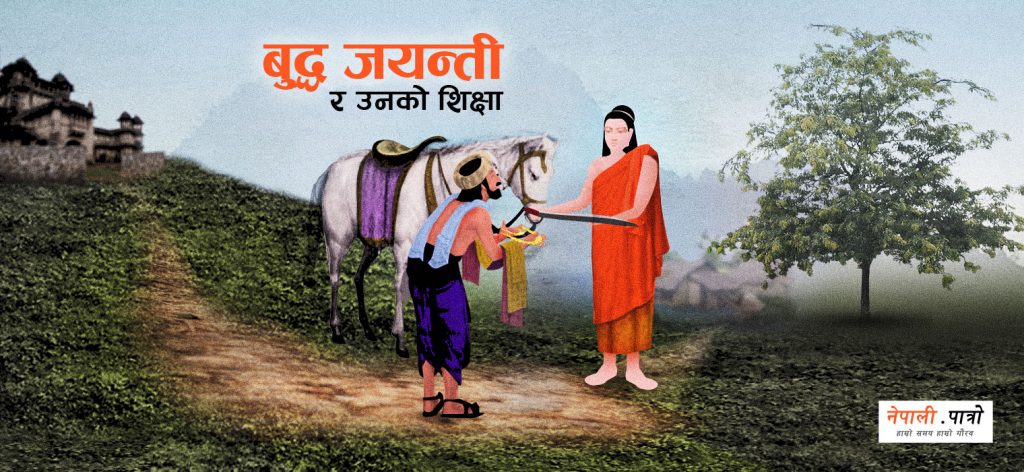
Buddha Jayanti and His Teachings
Buddhism, from When and Where did it Begin!
Buddhism began in a region of southeast Nepal in Asia during the mid-sixth century in Kapilvastu, a city under the kingdom of Lumbini of that time. The Lumbini and its surrounding area were ruled by a clan called Shakya, a leading faction of that time. Shakyas were traditionally believed to belong to a Kshatriya (warrior clan).
It is generally a belief that the vast majority of the population in Northern India (closely connected with Nepal) used to practice forms of Vedic Hindu traditions under the leadership of strong Bramhin (Bramhan) priesthood with rituals and beliefs centered strongly and largely on this-worldly concerns, like managing or even trying to control the weather for a good harvest, curing illness and so on, which actually was already being questioned of its efficacy by some of the population.
Individuals and small groups of religious seekers were already questioning issues like possible life after death, the notion of rebirth into other modes of existence i.e. lower or higher realms, etc. These questions were what gave birth to scriptures like Upanishads with their deep reflection on the nature of self and of greater spiritual realities. In those days if a person would deny the fundamental Vedic Hindu belief, that person would be immediately dubbed as a Nastika (those who deny).
Who was Buddha?
Siddhartha Gautam was born around 563 BCE (Siddhartha meaning “he who has achieved his goal”) later known as Buddha. He was born to a ruling elite of that time and his father Shuddodan and his mother were wealthy elite. On his birth, Suddhodan consulted religious specialists so as to know what portent the boy’s body might communicate. And he was told, The child is destined to become either a world renouncer or a “wheel-turning monarch” (Sanskrit: chakravartin) While in Suddhodan’s palace, Gautam lived a life of ease and pleasure as his father resolved that his son would take the path of power and influence.
The father surrounded him with wealth and beauty and arranged to marry him at 16 so that Siddhartha would not renounce worldly life. He eventually had a son named Rahula.
Four Sights!
Why Siddhartha left the luxury is due to him perceiving “Four Sights”: a dead body, old age, sickness, and an ascetic. On several of the occasions, he had to leave the palace despite his father’s instruction to the servants to clear off the road of any unsightly reminders of human frailty. But, Siddhartha encounters the existential situation of human beings and perceives those four realities of life.
Once Gautama saw an old person, bent and struggling to walk. He was explained by his charioteer that it is because of old age that people face hardship. He too has to eventually face it in his life. One day his another tour came across a leper lying by the way in great pain. Again he was explained: it is an illness, which can happen to many people. Yet in another of his tours, he saw a funeral; after his query, he got the answer that “it is death, and no one can escape from it. It is inevitable. Then one day he saw a strange thing: Gautama saw a young man by the side of the road, without any possession, yet seemed content. All these sightings generally known as “Four sights” laid the foundations of Siddhartha’s renouncement of the palace, and a journey towards the illumination called “Buddhahood”
The Great Renunciation !
Siddhartha Gautama, Buddha or light of Asia as we know him today, as per the traditional belief left his palace, renouncing comfort, all its pleasures, and securities. He crossed the palace walls in pursuit of a realistic understanding of the world and the human condition.
His Journey and Initial Teachings!
His father’s desire was not to allow Siddharta Gautama to perceive the harsher realities of life, which could cause him to renounce the world. However, Siddhartha perceived those four sights, and eventually, at 29 years of age, he left the palace, his own wife (Yasodhara), and a child (Rahul) to seek his own path. In Gautama’s life story Rahul his son reappears as one of the early monks and his second wife Yasodhara as one of his first Bhikhunni (nun).
Siddhartha after leaving the palace in his initial learning stage went to learn from two Jain teachers, Udraka Ramaputra and Arada Kalama. Siddhartha attained the highest samadhis under their guidance but was unsatisfied with their method. He thought he had not overcome suffering, which was the main reason why he renounced his palace and its comfort.
Later he joined a group of ascetics in Banaras/Varanasi subjecting himself to several years of austerity. He subjected himself to the greatest of penance, by taking only one grain of rice per day. He almost died during these ascetic practices. He eventually realized that such harsh methods of penance and asceticism would not yield enlightenment. He renounces them, determined to follow his own understanding of the path that he had learned from several Buddhas in his past lives.
His illumination, the “Buddhahood”!
Thinking it is better to follow the path that he had learned from previous Buddhas, he moved on and decided to meditate, that too alone, under a Pipal tree in Bodhgaya until he would achieve enlightenment. In the night of Enlightenment, he discovers the ancient path of the Buddhas; he dwells into forward and reverse the twelve links of dependent origination.
He eventually attains three knowledge: he remembers all his previous lives; he attains the divine eye to see the arising and passing of sentient beings and succeeds in completely eradicating all his afflictions, Finally he succeeded in achieving his goal to find the most basic truths of human life, which he encapsulates within “Four Noble’s Truth”. From that moment onward, he is known as the Buddha, the awakened one, who has realized the ultimate truth of our existence.
The Buddhist traditions do suggest that he experienced terrible interference or struggle before and after his enlightenment. These four interferences are called maras and are numbered as four: his own afflictions, the death, the aggregates, and a god called Devaputra-mara. It was the latter, the Devaputra-Mara, who summoned up all his mighty power to prevent Buddha’s enlightenment; Even after his enlightenment, the same Devaputra-Mara tried to prevent the Buddha from spreading his knowledge among people in general.
His First Discourse at Banaras!
The awakened one, the Buddha, initially thinks of not teaching the newly discovered truth to the world, as it would be difficult for people to grasp it. However, upon the request of Samhapati Brahma, he decides to teach the Dharma (Dhamma) for the good of many so that they could overcome suffering or dukkha. The Buddha discovered that it is “The Attachment”, which is the main cause of all human suffering. The cause of this attachment is due to perceiving the five aggregates as “self”. Once he returned back to Vanaras, he again met the five ascetics with whom he had parted company earlier due to his dissatisfaction with their harsh ascetic practices. And, he preached the first teaching known as “turning the wheel of law” to these five persons. Now, Siddhartha Gautam indeed was a “wheel turner” as told at his birth but not as the type his father had wanted or envisioned him to be. He died in Kushinagar at the age of 80 around 463 BCE. For almost forty-five years he turned the greatest of all the wheels of the Dharma.
The Four Noble Truths!
Buddha’s Teachings. Enlightenment can also be meant as grasping the fundamental realities/ truth which can be summed up as Four Noble Truths.
- There is a truth of suffering.
- There is a cause of suffering.
- Anything that has cause has cessation once the cause is removed.
- There is a path that can remove the cause of suffering.
Eightfold Noble’s Path!
The eight elements in the classical Buddhist formulation for a modest style of living a human life is the Eightfold Noble’s Path. These eight elements for such a life (modest life are divided into three larger categories: i) ethics ii) concentration and, iii) wisdom. This Eight-Fold Path can be further elaborated as follows: The wisdom has two parts, the right view, and right intent. The concentration has three parts: right effort, right mindfulness, and right concentration. Ethics too has three parts: right speech, right action, and right livelihood. Buddha Jayanti and His Teachings
The most important of all is the wisdom part. It is mentioned in several Buddhist scriptures that all the other limbs are directed by wisdom, as it is likened to an eye. The right view offers a direction to the whole system. It is mainly having the right type of knowledge of reality, without any error. In brief, seeing the dharma-s or all phenomena as impermanent, suffering, no-self, and empty of self-nature is the essence of the right view. Right Intent has again three parts: the intent to renounce the world; the intent to not cause suffering and the intent to not harm. The last two are also defined as loving-kindness and compassion. Buddha’s Teachings
One more intention is added in Mahayana, i.e., the aspiration of Bodhicitta, the intention to achieve the Buddhahood to help all the sentient beings.
As for the ethics, it is mainly related with/to how we behave and conduct with other sentient beings. Hence, we are required to have the right type of speech. That is to say, we are not supposed to lie, say divisive words, not use harsh words, and not engage in useless small talk. Right effort is related with those activities and action we do that is beneficial to both ourselves and others. The right livelihood is about avoiding wrong types of livelihood that harm sentient beings such as not selling poison, weapons, not trading sentient beings, intoxicants, and meat. Buddha’s Teachings
Right Concentration, the third category is also further divided into three parts, as mentioned earlier. First comes the right vyaayaama means putting the right type of exercise to deal with the thoughts. It is mainly increasing the wholesome thoughts and removing unwholesome thoughts from the mind. Buddha’s Teachings
The right mindfulness is to practice the four stations of mindfulness, that is to say, the mindfulness of body, sensation, the mind, and the phenomena. It is well defined in the suttas such as the Sattipatthaana Sutta. The right samadhi or absorption is about practicing Samatha meditation. It is about entering into four main samadhis, which are also called ‘dhyaanas” or “Samaapatti-s”. Buddha’s Teachings
From the above explanation of the eightfold path, we can surely say with confidence that Buddha being a true hardheaded realistic person, of course, did not send his followers in a wild goose chase, did he? He did not. He suggested a method to achieve a balance in everyday life experience and this teaching of balanced approach is known as the “middle path”. It is called the middle path (Madhya-marg) as it aims for balance, propriety, and equanimity. Consume as per your hunger. Use whatever is necessary for a very modest life as a normal human being. If you eat too much, more than your body needs, you surely will have an upset stomach. Isn’t that so? Therefore, follow the middle path and be happy.
Bhavatu Sarva Mangalam!!!
Buddha’s Teachings.
This extensive article has been prepared with much-needed help from the friendly hands of Mr. Bibek Sharma.
